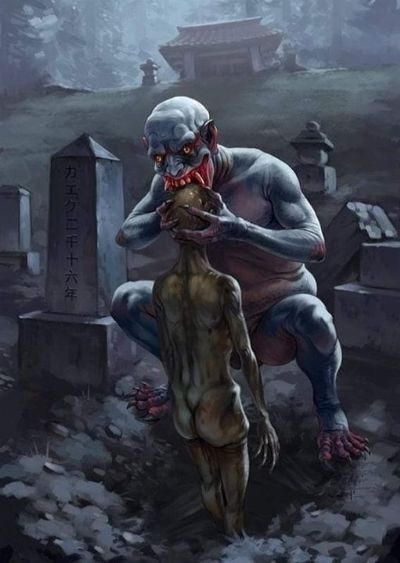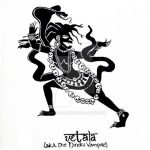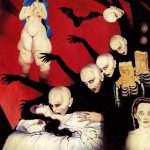Vetala
Aka: Baital, Baitala, Betail
The vetala is an evil spirit in Indian folklore who haunts cemeteries and takes demonic possession of corpses. They make their displeasure known by troubling humans. Victims reanimated by a Vetàla would always have their hands and feet pointed backwards. They can drive people mad, kill children and cause miscarriages but they also guard their villages.

They are hostile spirits of the dead whose children did not perform funerary rites in their memory. As a result they are trapped in the twilight zone between life and after-life. These creatures can be appeased with gifts or frightened them away with spells. One can free them from their ghostly existence by performing their funerary rites. Being spirits, unfettered by the laws of space and time, they have an uncanny knowledge about the past, present and future and a deep insight into human nature. Hence, many sorcerers seek to capture them and turn them into slaves.
A sorcerer once asked King Vikramaditya to capture a vetala who lived in a tree that stood in the middle of a crematorium. The only way to do that was by keeping silent.
However, every time Vikramaditya caught the ghost, the ghost would enchant the king with a story that would end with a question. No matter how hard he tried, Vikramaditya would not be able to resist answering the question. This would enable the vetala to escape and return to his tree. The stories of the vetala have been compiled in the book “Vetala-pachisi”.
Rakshasa
A rakshasa (fem: rakshasi) is a vampiric ghoul or demon who in old tales haunts charnel grounds (cemeteries and cremation grounds) but, in modern Indian folklore, dwells in trees.
A rakshasa can appear in many forms, as a beautiful woman or as an animal such as an owl, a bat, a vulture, a monkey, or a dog. They have also the power to take half-human and half-animal shapes. In their essential form, they have fangs and unkempt hair, and are covered with blood. The rakshasas’ favorite prey are infants and young children.
Pisacha
A pisacha is a vampiric spirit often associated with the vetala and the rakshasa but of a lower order than both of these. They are said to be hideous in appearance and blood thirsty. They haunt charnel grounds and cross-roads. They are blamed as the cause of many illnesses. But, if offered rice at a cross-road by one of his victims in a ceremony that is repeated for days, he might restore his health. The name pisacha is occasionally used in a way that includes all or nearly all the vampiric demons and spirits of India.
Bhuta
Aka: Gayal
The term Bhuta is sometimes applied in a way that includes all of the Hindu vampiric demi-gods, demons, and undead. But its special meaning is the revenant of a man who died under such circumstances as accident, execution as a criminal or suicide , unmarried or without an heir. In some regions of India, a Hindu who dies under such circumstances is buried instead of being cremated and given a proper funeral .
The bhuta often satisfies its appetite by eating the intestines and excrement it finds in other corpses. But it also attacks humans, causing them to become sick, and death often results, concentrating upon his relatives and the sons of his neighbors.
The methods to get rid of this pest include exhuming the body and giving it a proper funeral in which it is cremated. Another way is to place cups around the grave containing a mixture of milk and water from the Ganges River as an offering to appease it. Burning lamps might also be placed around the grave. To protect male children from the gayal, a necklace of coins was sometimes placed around their necks.
Churel
The Churel is the revenant of a woman who dies when bearing a child or has somehow broke some religious taboos when dying.
The basic form of the churrel is sometimes described as having reversed feet and no mouth. According to another description, she has long, pendant breasts, sharp long teeth, unkempt hair, and a black tongue. But she can appear as a beautiful young woman who seduces young men and keeps them enthralled, draining them of their vitality, until they prematurely become grey-haired old men. She preys mainly upon her relatives. The ways to prevent or get rid of a churrel include:
- Piercing the thumb and fore-fingers of the corpse with nails.
- Binding the the toes of the corpse together with an iron ring.
- Breaking the legs of the corpse above the ankles.
- Burying the corpse the corpse face downwards.
- Burying the corpse in a special place such as one near the house which was always in shadow at high noon.
- Fixing an iron nail at each of the four corners of the burial site.
- Placing millet or mustard seeds, or thorns or iron nails, in the grave itself and/or on the ground above the grave.
- Placing millet or mustard seeds on the road between the grave and her former home.
- Placing millet or mustard seeds, or thorns or iron nails on the thresholds of her former home.The practices involving millet or mustard seeds had to do with notion that the revenant became pre-occupied with counting these. The same practices and belief here concerning seeds and such occurs in Eastern Europe and, at least to some degree, in many other parts of the world.
- Ritual offerings and rites of exorcism performed at the site of the grave
- Sometimes the corpse was cremated. But then a ball of thread is burned with it in belief that the woman’s spirit will be so occupied with unwinding the ball that she will forget the gripe she has with her relatives.








